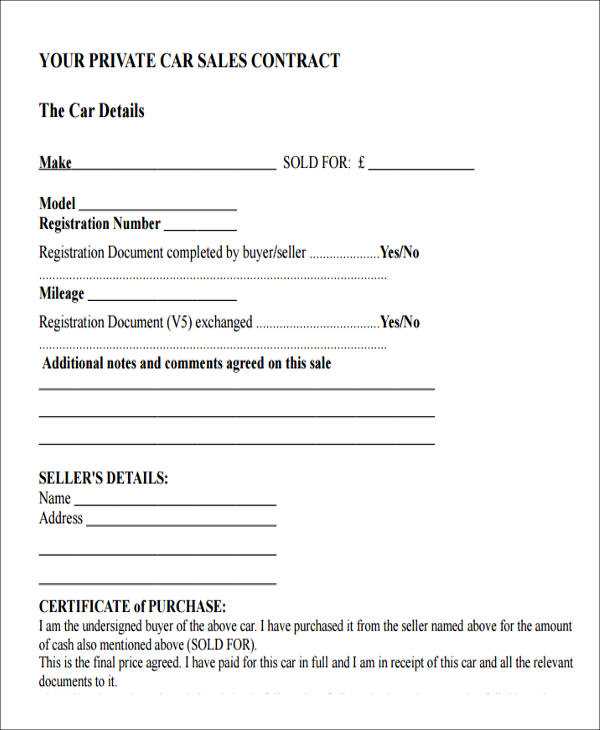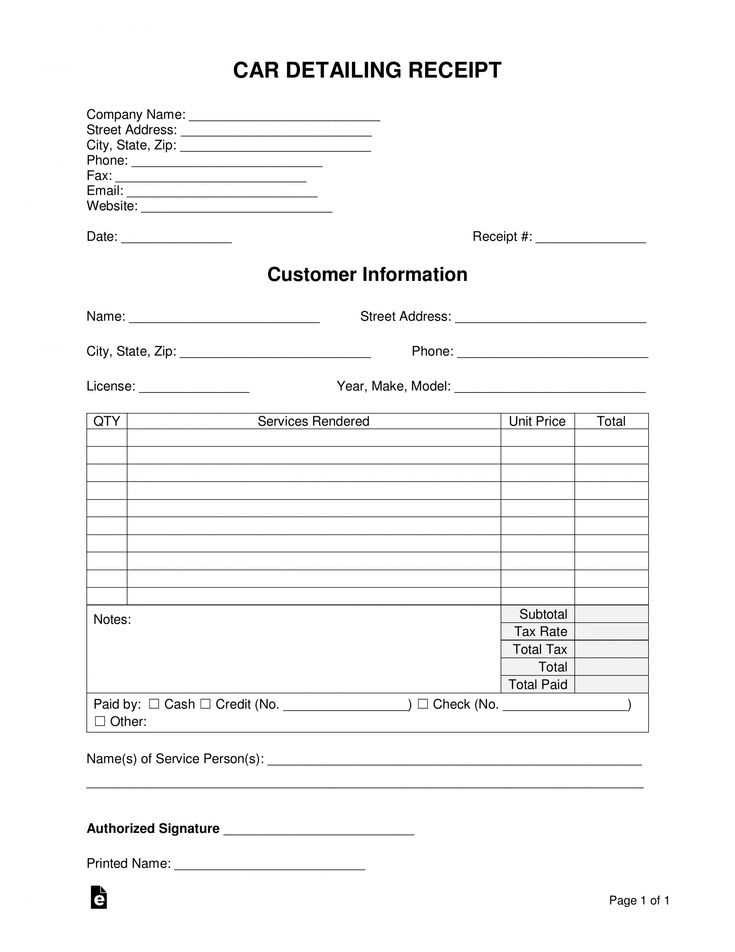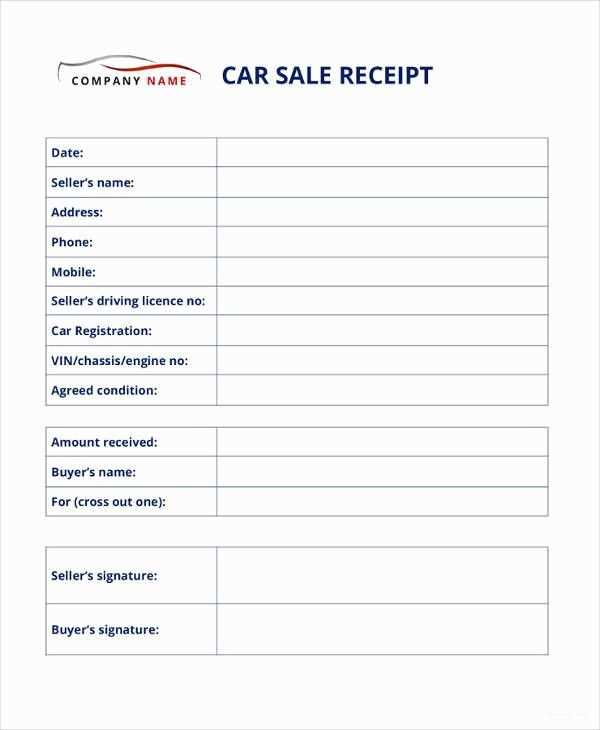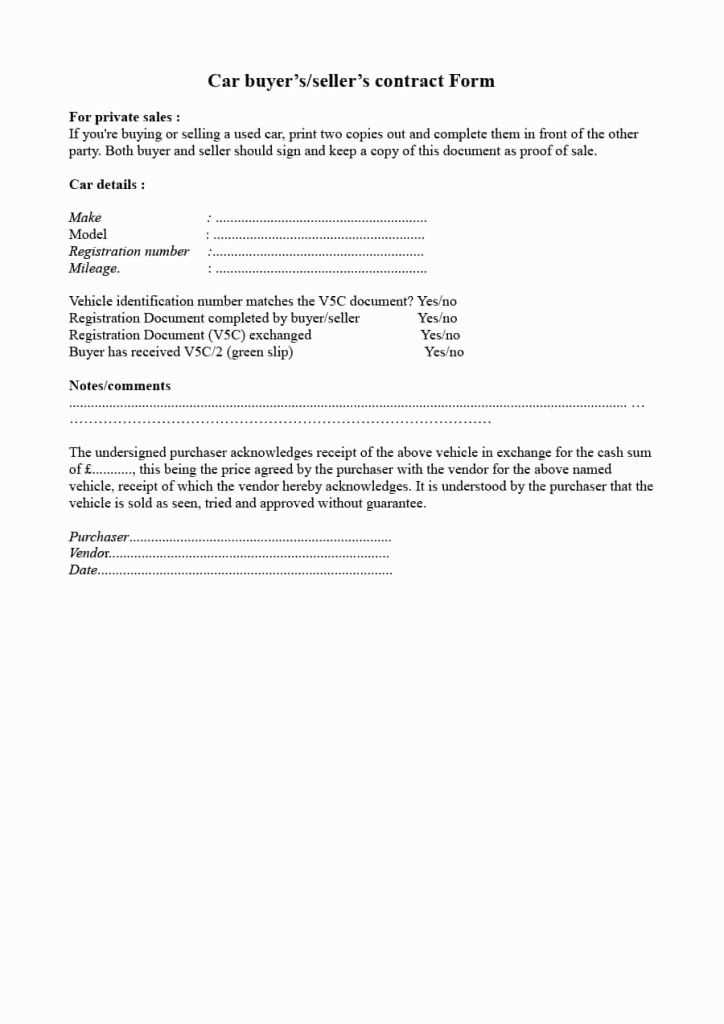
To make your used car purchase process smooth and transparent, it’s important to have a detailed receipt. This document serves as proof of the transaction and protects both the buyer and the seller. Below is a simple yet thorough receipt template that you can customize according to your needs. Having all the relevant details on the receipt ensures clarity and prevents misunderstandings down the road.
Start with the full names of both the buyer and the seller. Include their contact information–phone numbers and addresses–so it’s easy to reach them if needed. Don’t forget to record the date of the sale and the specific vehicle details such as make, model, year, VIN (Vehicle Identification Number), and current mileage. This helps identify the car in case of any future issues or disputes.
The agreed sale price should be clearly stated, along with any payment method used, whether it’s a bank transfer, cash, or cheque. If a deposit was made prior to the full payment, be sure to list the deposit amount and when it was paid. Both the buyer and the seller should sign the receipt, confirming that all details are accurate and that the car has been transferred as agreed.
Don’t forget to add a disclaimer if necessary, such as “sold as-is” or any warranty details if applicable. This ensures both parties are aware of the terms and conditions surrounding the vehicle’s condition and future responsibility.
Receipt Template for Buying a Used Car
Include key details to ensure a valid and clear receipt. Begin with the names and addresses of both the buyer and seller. Specify the car’s make, model, year, Vehicle Identification Number (VIN), and odometer reading at the time of sale. Include the agreed sale price and payment method (cash, check, or other). Be sure to note if the car is sold “as-is” or with any warranties or guarantees.
Key Sections to Include
Buyer and Seller Information: List full names, addresses, and contact details of both parties.
Car Details: Include make, model, year, VIN, and mileage at the time of purchase.
Sale Information: Clearly state the sale price and the agreed payment method. If applicable, include any deposit paid and the remaining balance.
Additional Notes

If the transaction includes any special conditions (e.g., repairs or modifications), mention them in the receipt. This can help prevent misunderstandings in the future.
Finally, ensure that both parties sign and date the receipt. It serves as proof of the transaction, which could be important for registration or any potential disputes down the line.
How to Properly Format the Vehicle Information Section

Be clear and concise when presenting vehicle details in the receipt. Ensure the section is easy to read, providing the buyer with all necessary data. Include the following key elements:
- Make and Model: Clearly specify the manufacturer and model of the car.
- Vehicle Identification Number (VIN): List the VIN exactly as it appears on the car. This unique number identifies the vehicle and is crucial for ownership records.
- Year of Manufacture: Include the year the vehicle was made, which can usually be found on the registration or title documents.
- Odometer Reading: State the exact mileage at the time of the transaction. This number must be accurate to avoid disputes later.
- Color: Mention the primary color of the vehicle. If the car has multiple colors, list all relevant ones.
- License Plate Number: Include the vehicle’s current registration plate number to confirm its legal status on the road.
- Condition: Specify any known damages or repairs. Honesty here builds trust between the buyer and seller.
Make sure the text is legible by using clear spacing and bullet points. Avoid jargon, and focus on factual details only. Double-check all information for accuracy before finalizing the receipt.
What Payment Details Should Be Included in the Receipt

Include the exact amount paid, specifying both the total price and any applicable taxes. If the payment is made in installments, note the amount of each installment and the schedule for remaining payments. Specify the method of payment, such as cash, bank transfer, or check, and mention any reference numbers associated with the payment, such as transaction IDs or check numbers.
Payment Breakdown
If there are any additional fees or charges related to the car purchase, list them separately. Include any down payment amount, showing the balance due after it. Clarify if the payment covers all costs, such as registration fees, or if they are billed separately.
Buyer and Seller Information
Ensure the receipt includes the full name, address, and contact details of both the buyer and the seller. Include the date of payment and a clear statement that the transaction has been completed. If applicable, also add details of the car, including the make, model, year, and VIN (Vehicle Identification Number).
Legal Considerations When Writing a Receipt for a Used Car

Clearly state that the transaction is for a used vehicle to avoid any confusion. Include both the buyer’s and seller’s full names, addresses, and contact details. Specify the make, model, year, Vehicle Identification Number (VIN), and any relevant registration or license plate information for the car. These details should be accurate to prevent disputes.
Clear Agreement on the Condition of the Car
It’s critical to describe the car’s condition in detail, noting any known defects or issues. Use phrases such as “sold as-is” to make it clear that the buyer accepts the car in its current state. This protects the seller from future claims regarding the car’s condition once the sale is complete.
Payment and Price Terms

Indicate the total purchase price and the form of payment (cash, check, or bank transfer). If a down payment or installment plan is involved, specify the amount and any terms associated with the remaining balance. A receipt should include the date the payment was made to confirm the transaction.
Both parties should sign the receipt to confirm that they agree to the terms. It is recommended to have a witness present to sign as well, especially if the transaction involves significant sums. This adds an extra layer of security and helps resolve any potential disputes down the line.


